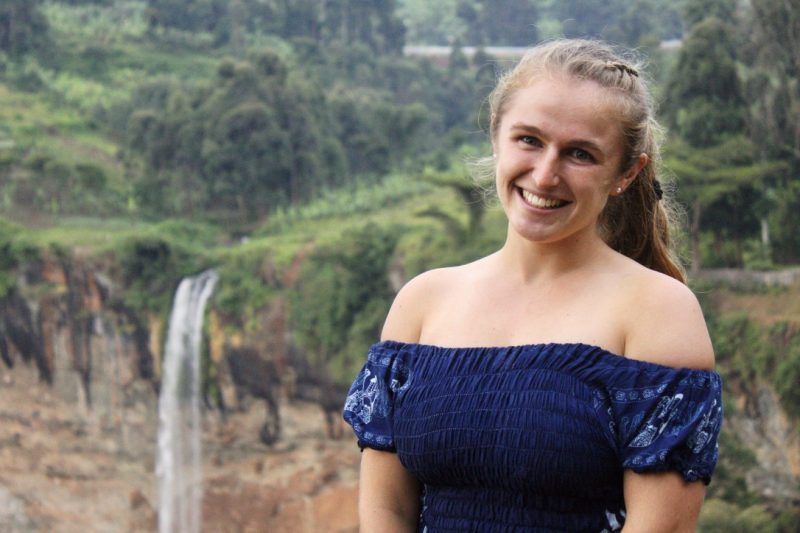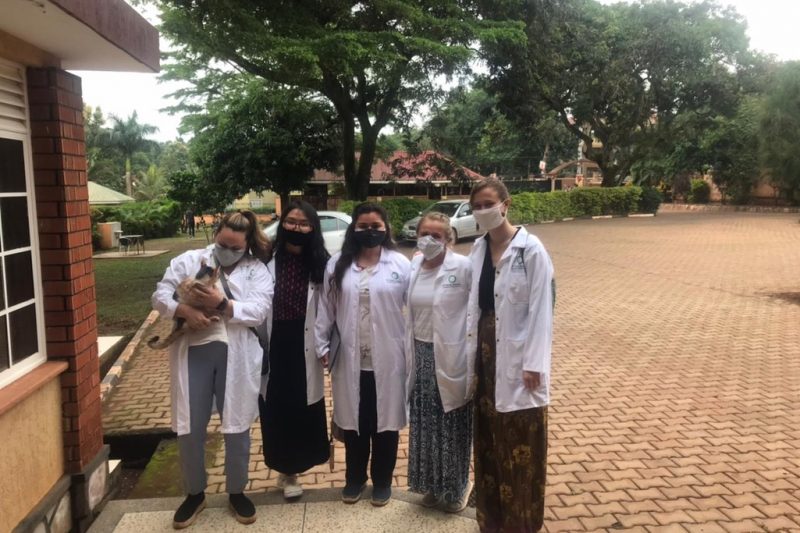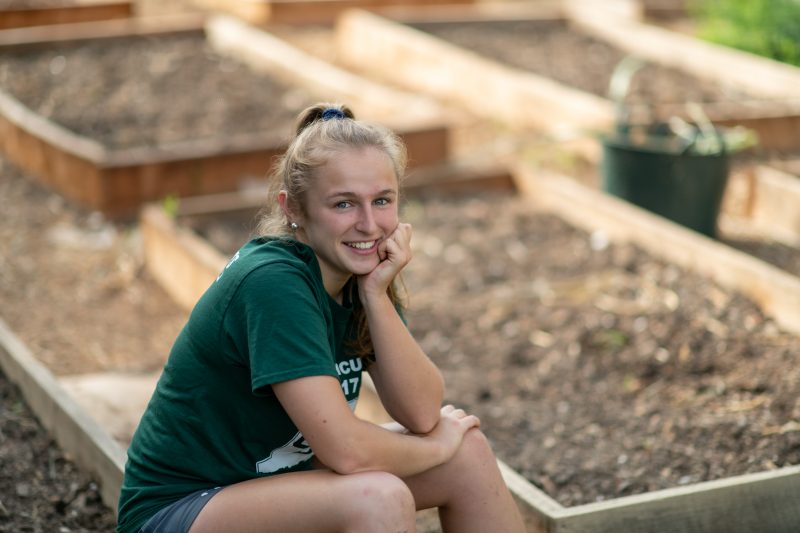‘Chasing After Curiosity’ Allie Stankewich '23 spent summer 2021 learning about public health in Uganda and green roofs in New York City.
Hometown: Guilford, Connecticut
Major: Sociology and Environmental Studies
Minor: Poverty and Human Capability Studies
“This liberal arts institution has taught me of the value of interdisciplinary thinking and approaches to global issues, and I got a taste of how much is possible when I go after what I am passionate about.”
Q: What did your internship in Uganda entail this summer, and what was a typical day there like?
I participated in the Public Health in the Tropics Internship in Jinja, Uganda, through School for International Training (SIT). Immersing in the culture of Uganda taught me more than I could have imagined about how multifactorial and intersectional public health is, and it opened my eyes to various sociocultural, economic and medical barriers to achieving equitable, accessible health care and management. I also had valuable conversations with various health workers and researchers on how this region—and health systems globally—are creatively developing solutions and interventions, all while adapting to the pandemic and the profound impacts it has had on Uganda and public health overall.
Three days a week, we had morning Swahili classes, where we learned language fundamentals with a native Kenyan instructor. Other days we had morning seminars that focused on various components of public health, including the ethics of clinical practice and research, comparative global health care systems, and research sessions with Uganda’s published health records and data. For these data research projects, we worked with a biostatistician through the Ministry of Health and focused on individual topics of choice relevant to patterns and patients at Jinja Regional Referral Hospital and its branch, Nalufenya Children’s Hospital, the internship’s primary partners.
We also had afternoon sessions each day, which were typically lectures and discussions with different health professionals from different perspectives in the field: clinical, administrative, research, public, nonprofit, traditional medicine and rural village health teams. Because of COVID-19, the speakers came to us instead of letting us visit their facilities, but we were still able to meet so many knowledgeable people. These lectures covered scientific background of the diseases, medical practices for diagnosis and intervention, and the social and cultural implications of these health concerns in Uganda. Nearly all of these conversations were intersectional and touched on the priorities of HIV, malaria, malnutrition, tuberculosis, and sexual and reproductive health challenges. Of course, now each of these health issues, among others, was overlaid with complications amid the COVID-19 pandemic, and it was interesting to learn about the different responses, impacts and norms around the virus in Uganda versus the U.S.
Beyond these classes, seminars and lectures, we spent about one afternoon per week in the public regional children’s hospital, where we observed the facilities and interviewed the doctors, nurses or counselors in different units. I spent some time in the pediatric malnutrition unit, HIV clinic and triage center, and had insightful conversations with these clinical health workers and counselors about their work, effects of the pandemic on their unit, and general reflections on the significance of it all. We also got to visit The AIDS Support Organization (TASO), an NGO focused on AIDS therapy, care and psychosocial support, and a critical resource for this community. Being exposed to health facilities and observing the behaviors and needs of patients, practitioners and community members involved with health care taught me so much and raised questions that I want to further explore.
In addition to daily morning and afternoon sessions, students in the program had a free window to explore the city of Jinja, get lunch, shop and meet community members. We got to know vendors and waitstaff personally and got to try so many different places for food. Evenings and weekends also quickly became filled with immersive cultural experiences and time with Ugandan friends. We tubed and kayaked on the Nile River, took a boat ride to a fishing village across Lake Victoria, and visited Sipi Falls for a scenic waterfall hike and traditional cultural storytelling dance performance. We also spent countless hours playing a traditional card game, “Matatu,” with friends, and talking and sharing memorable conversations that taught me more than anything else. Ugandan culture surfaced in each of these interactions, as did themes of public health, which are so relevant and connected to every person, everywhere.
Q: How did you get connected with that opportunity?
Coming into college, I knew I wanted to experience study abroad in some capacity, though once I arrived on campus, I realized it wasn’t so easy to leave behind the people and experiences in Lex that are already flying by way too quickly! I decided to look into options for a summer study abroad program and am grateful for the guidance and support of Cindy Irby and our Center for International Education. I started by surfing online through countless programs, countries and subject areas, realizing they all sounded incredible but feeling overwhelmed by the seemingly endless options. In fact, I had applied for a public health internship in Mexico before it got canceled this summer because of COVID-19. That whole process was made a bit easier when Cindy helped guide me to specific programs based on my individual interests and academic goals.
She introduced me to SIT, and I was drawn to their mission of examining and addressing critical global issues through immersive, field-based learning in order to create a more sustainable, peaceful and just world. From there, I explored the many different options for summer study abroad and intern abroad choices all over the world, keeping my focuses of environmental sustainability and/or health care in mind. That led me to a Public Health in the Tropics Internship, originally located in Kenya. It was a long process of many variables up in the air and discerning whether or not it really made sense to go through with studying abroad knowing how volatile all the circumstances were with COVID-19—obviously a big one being that the program country was changed to Uganda—but the SIT admissions counselors and W&L’s study abroad office answered my many questions and gave me confidence that this opportunity would be safe and fulfilling. After a long time considering the pros and cons of traveling at this time and discussing it with different mentors, I decided to go forward with it. Now, I am so grateful I got connected with the many valuable resources at W&L and SIT to experience one of the best summers of my life.
Q: What was your favorite part of the experience? And what was the most challenging part?
My favorite part of this experience was building relationships with so many wonderful people in Uganda and seeing the applications of our internship focus play out through the engagement we had with the local community of Jinja. Public health, as I have continued to learn, is woven through all elements of life and affects every person. Public health constitutes sociocultural traditions and values, patterns of human behavior and interactions, economic and political policies, and people’s physical environment, and as a result, our learning transcended the boundaries of our classroom lectures and hospital shadowing. In fact, some of my richest learning experience came from spontaneous conversations with servers at restaurants, in the back seat of tour buses, over shared meals, and during heated card games with new groups of friends!
Having to adapt to the COVID-19 lockdown that was implemented in Uganda the first week we arrived was challenging and could have been frustrating in many situations. For example, there was a 7 p.m. curfew that made it hard to get dinner after our afternoon internship sessions. Being in a new place, I wanted to explore and be around people, but in this unique time, we had to consider the implications of responsible community engagement. Our program adjusted and modified as time went on and the COVID-19 situation tightened or eased up, so while it was disappointing to miss working more directly in the hospital and research center and gaining professional work experience in facilities as we had hoped, there were still countless opportunities to learn and take on remote projects, as well as having speakers and health professionals come to us to teach.
Despite having fewer opportunities to do the initially planned hands-on work, it brought some of the most wonderful spontaneous, organic relationships and interactions with local community members, many of whom became friends. One of my favorite moments from this summer was an evening when a friend and I went for a walk through a nearby neighborhood, where we were drawn to a home where music was playing and children were giggling and dancing in the front yard. The driveway was adorned with original paintings and sculptures in a scene of both joy and social activism. The children enthusiastically invited us into their yard to join in the dancing and music, and we talked, played and laughed. The next time we walked by, we stopped and met their father James, the artist of these pieces and an inspiring community activist in the local rural village. James put aside what he was doing to sit down and talk with us. He was eager to show us a children’s picture book that he wrote and illustrated about malaria prevention and safe practices. He also has worked with young girls for education and health initiatives, teaching them how to make homemade, washable sanitary pads from affordable, accessible cloth materials. It was inspiring to see the way this community member has empowered so many others and communicated critical messages about public health practices through creative means like artwork, stories and crafts. James enriched my perception of effective methods for implementing health interventions and responses, as well as the power of community sensitization, especially in the way that a male was leading this typically culturally taboo conversation on menstruation and sexual health. It was small moments and interactions like these that made this abroad experience unforgettable.
Q: You also received a Johnson Opportunity Grant to spend some time with the Green Roof Research Project. Tell us a bit about that.
My friend Jensen Rocha ’23 and I developed an interest in green roofs last winter after Jensen studied the topic for an Environmental Economics class project. With our involvement in the W&L Environmental Studies Program, we were curious to see more green roofs in the field and learn about different professions relating to environmental issues and responses. We began initial research on various green roof organizations across the country and sent emails to individuals we were interested in connecting with. It was exciting to see how many people responded and were eager to share their work with us and offer their time to meet. We connected with Dr. Dustin Partridge of Green Roofs Research Alliance in New York City, and he taught us about his own work and green roofs in general, and helped us develop an itinerary of sites to visit, and people and organizations to meet, across the city. Our project became geared toward a brief research residency with the NYGRRA, and the Johnson Opportunity Grant made possible our week-long experience staying in NYC to conduct this work.
Our goal was to conduct initial exploratory, primarily qualitative research by interviewing people in the field and making observations about the different facets of green roofs in order to develop a more concrete research question to potentially be used for a future capstone or research project. Initially, we were interested in the impacts of green roofs on community health and mental health and well-being. We also had questions about the process of installation and maintenance and the impacts green roofs have on air quality, waterways, and energy efficiency, among other things. While we were in New York, Jensen and I were able to visit several green roof sites, including the High Line, the Javits Convention Center, Newtown Creek Alliance, Kingsland Wildflowers Community Engagement Center, NYC Parks and Recreation, and P.S. 41 elementary school. We had very interesting conversations with people who brought various perspectives from backgrounds in science, education, policy and legislation, public advocacy, economics and the environmental lens.
We learned that green roofs are emerging as a solution to consequences of urbanization in New York, but rooftops are still an underutilized asset. They have great potential for sustainable development and resiliency. However, less than 0.1% of rooftops are green roofs and they are mostly concentrated in Manhattan. With affordability and access barriers, historically marginalized communities in the city continue to experience more adverse effects of the urban heat island effect and poorer air and water quality, all issues that green roofs serve to improve. There have been recent legislative movements to push for increased incentives for installation such as tax abatements, as well as a requirement that all new roofs or major renovations must include a green roof and/or solar energy. Overall, Jensen and I learned so much in just the single week and enjoyed meeting experts in the field and immersing ourselves in the NYC environment.
Q: How do you expect these experiences to impact your W&L education and your future career?
This summer provided me two amazing experiences that were rich with learning and engaging with new people and perspectives. My time in Uganda reaffirmed my passion for public health and sparked a lot of further questions that I hope to continue to explore, both about the region and culture of East Africa, and about various components of health. I am still deciding what form that will take, whether it be future research or a capstone at W&L, or even post-grad work with issues of global health, but with a major in sociology, I can continue to strengthen my qualitative and quantitative research skills and explore ways to address disparities in social opportunities and outcomes.
I also want to continue to apply the environmental lens and delve deeper into environmental health. Through conversations and informal interviews with people I met both in Uganda and New York, I learned firsthand about consequential interactions between human communities and their environment. Many of these themes intersected with conversations I have had in poverty studies classes, and I want to continue learning about the issues at hand to steer a career path toward promoting the well-being of both people and our environment. I am excited by the opportunities that W&L and my advisers continue to afford me to focus on my passions and creatively intersect them in a personalized way.
Q: What have you learned at W&L that helped you in these endeavors?
W&L has nurtured an abundance of skills and growth for me, both personally and academically. This summer, I was able to lean into a great deal of independence. W&L has fostered my ability to advocate for myself, communicate with adults and act on my curiosity through inquiry. Small class sizes and personal relationships with professors have allowed me to ask lots of questions, and I have grown more comfortable seeking answers beyond what is in the syllabus or lesson plan. I appreciate these relationships and the learning that happens through personal conversations and storytelling. This has also allowed me to seek challenges or make the most out of the exceptional people and resources available to me. This applied to my study abroad experience because the COVID-19 limitations took away components of the program, but I was confident in my inquisitive nature and curiosity to deeply and authentically explore the community and seek small projects and experiences beyond the initial syllabus. Those often turned out to be moments where I felt like I learned the most and where my individualized interests could shine. Overall, I could capitalize on my ability to think freely and critically as a global citizen engaged in a diverse setting by individualizing my learning, chasing after curiosity, and building meaningful relationships.
The faculty at W&L have also enabled me to find a path within my classes and extracurricular involvements that intersects my various interests. This unique advantage helped me find these summer experiences and go out of my comfort zone to plan, initiate, travel and personalize the applications of my learning on health, the environment, and different cultures and communities of people. This liberal arts institution has taught me of the value of interdisciplinary thinking and approaches to global issues, and I got a taste of how much is possible when I go after what I am passionate about. I have learned at W&L and through my recent fieldwork and program that there are so many different career paths and options beyond just becoming a doctor, and now that I have been exposed to so many different perspectives and roles in the fields of health and sustainability, I hope to return to our Career and Professional Development center for guidance on discerning which path is best for me.
If you know any W&L students who would be great profile subjects, tell us about them! Nominate them for a web profile.
 Allie Stankewich ’23 in Uganda
Allie Stankewich ’23 in Uganda Allie Stankewich ’23 stops for a picture with fellow interns in Uganda.
Allie Stankewich ’23 stops for a picture with fellow interns in Uganda.

 Allie Stankewich ’23 in the W&L Campus Garden
Allie Stankewich ’23 in the W&L Campus Garden
You must be logged in to post a comment.